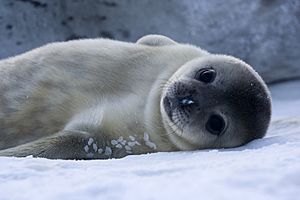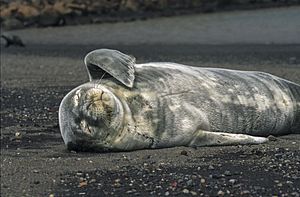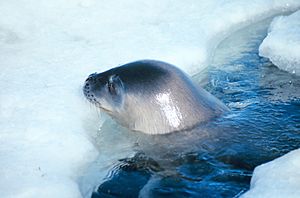Weddell Seal facts for kids
Quick facts for kids Weddell seal |
|
|---|---|
 |
|
| At the D'Hainaut Island, Mikkelsen Harbour, Trinity Island | |
| Conservation status | |
| Scientific classification | |
| Genus: |
Leptonychotes
|
| Species: |
weddellii
|
 |
|
| Weddell seal range
Water Ice Range |
|
The Weddell seal (Leptonychotes weddellii) is a large and common true seal. It lives all around Antarctica in the Southern Ocean. This seal was found and named in the 1820s. It was named after James Weddell, a British captain who explored the area. Scientists know a lot about Weddell seals. This is because they live on ice close to the Antarctic continent. They are often near research bases.
Contents
What Does a Weddell Seal Look Like?
Weddell seals are quite big. They are about 2.5 to 3.5 meters (8 to 11.5 feet) long. They can weigh 400 to 600 kilograms (880 to 1,320 pounds). This makes them one of the largest seals. They have a strong body and short front flippers.
Size Differences Between Males and Females
Male Weddell seals usually weigh less than females. Males are often 500 kg (1,100 lb) or less. Males and females are generally the same length. However, females can be a bit larger. Males tend to have a thicker neck and a wider head. Scientists can even use genetic tests to tell their sex.
Their Fur Coat and Features
Weddell seals have a thin fur coat covering most of their body. The color and pattern of their fur can change. It often gets duller as they get older. They shed this coat around early summer. Adults are usually bluish-black or dark gray on top. Their bellies are light gray or silver. Their faces look a bit like a cat's. They have a short mouth and similar noses and whiskers. Their whiskers are very important for sensing.
Baby Weddell Seals: Pups
Baby Weddell seals are called pups. They are born with a soft, fuzzy coat. This coat is similar in color to the adults. Pups shed this coat after 3 to 4 weeks. Then, their fur turns darker, like adult seals. Newborn pups are about half the length of their mothers. They weigh 25 to 30 kg (55 to 66 lb). They gain about 2 kg (4.4 lb) every day. By 6 to 7 weeks old, they can weigh around 100 kg (220 lb).
How Weddell Seals Behave
Where Do Weddell Seals Live and Move?
Weddell seals often live on "fast ice." This is ice that is attached to the land. They gather in small groups around cracks and holes in the ice. In winter, they stay in the water to avoid snowstorms. Only their heads poke through breathing holes. When on land, they often lie on their sides.
These seals do not travel far from their homes. They move around locally to find breathing holes. The location of these holes changes with the seasons. They mostly stay in Antarctic waters. Things like moving glaciers and tides can also affect where they are found.
How Do Weddell Seals Find Food?
Weddell seals dive deep to find food. They also dive to keep their breathing holes open. They can dive as deep as 600 meters (about 2,000 feet). They can stay underwater for up to an hour. They dive deeper during the day than at night. After leaving a breathing hole, they become heavier than water. This helps them dive with less effort.
Weddell seals are top predators in Antarctica. They eat many kinds of fish. They also eat bottom-feeding prawns, cephalopods (like squid), and crustaceans. A seal that is not very active eats about 10 kg (22 lb) of food a day. An active seal eats over 50 kg (110 lb) a day. Their main foods are Antarctic cod and silverfish. They also eat cephalopods often. They are smart hunters and eat whatever food is available.
Do Weddell Seals Hunt Penguins?
Weddell seals usually do not eat seabirds. However, some have been seen chasing and killing penguins. Other seals in Antarctica are known to hunt seabirds. This suggests that hunting penguins might be a learned behavior for some Weddell seals. There are records of them attacking four different penguin types. These include gentoo penguins, emperor penguins, Adélie penguins, and chinstrap penguins. It is not confirmed if the seals ate the penguins after killing them.
How Do They Sense Their Prey?
Scientists think Weddell seals use their eyesight to hunt when there is light. But during the dark Antarctic winter, they rely on other senses. They mainly use their vibrissae, or whiskers. These are not just hairs. They are complex sense organs with over 500 nerve endings. These whiskers help seals detect the movement of swimming fish. This allows them to catch prey in the dark.
Who Hunts Weddell Seals?
Weddell seals have no natural predators when they are on fast ice. In the open sea or on floating ice, killer whales and leopard seals hunt them. These predators mostly target young seals and pups.
Life Cycle and Reproduction

Weddell seals return to fast ice areas in spring to give birth and breed. They often use the same breeding spots year after year. Depending on where they live, they give birth from early September to November. Seals in warmer areas give birth earlier.
Giving Birth and Raising Pups
Weddell seals usually have one pup each year. But they are one of the few seal species that can have twin pups. Giving birth takes only 1 to 4 minutes. Newborn pups weigh about 25 to 30 kg (55 to 66 lb). They double their weight in their first week! Pups take their first swim when they are 1 to 2 weeks old.
For the first two weeks, mothers recognize their pups by smell. They also use special sounds. They stay close to their pups. After 6 to 7 weeks, pups stop drinking milk from their mothers. They then start hunting for food on their own.

Mating Season
The mating season is in late November and December. This is after the pups are weaned. During this time, male Weddell seals make very loud noises. These sounds can even be felt through the ice! Males protect their underwater territories during breeding. They have been seen fighting each other.
Seals are usually 6 to 8 years old when they first breed. But some females can breed much earlier. Weddell seals have a special process called "delayed implantation." This means the baby seal (embryo) does not attach to the mother's womb right away. It waits until mid-January or mid-February. This allows the pup to be born when conditions are better.
How Long Do They Live?
Young Weddell seals (0-2 years old) have a higher chance of not surviving. After 2 years old, their survival rate is similar to adults. Weddell seals can live for at least 25 years.
How Weddell Seals Communicate
Male and female Weddell seals use many different sounds to talk to each other. Males sometimes use "trills" to communicate. Seals on the ice can hear seals in the water. This works if it's quiet on land and they are close. Sound can travel through the ice or from water to breathing holes. Female seals often breed near these holes.
Scientists have recorded Weddell seal "songs." These songs are repeated patterns of sounds. They change only slightly over time. Each seal can have its own unique song. However, singing is not a common behavior.
Sounds are also important for mothers and pups. Mother seals use sounds to call their pups from far away. This is useful when smell is not enough. Pups also make louder, more urgent sounds when they are hungry. This tells their mothers to feed them.
Weddell Seal Family Tree
The scientific name for the Weddell seal is Leptonychotes weddellii. In the past, it was sometimes misspelled as L. weddelli. But this spelling is no longer correct.
Weddell seals can sometimes be confused with two other seals. These are the Ross seal (Ommatophoca rossii) and the crabeater seal (Lobodon carcinophagus). They all live in the same areas.
How Many Weddell Seals Are There?
Weddell seals are the second most common type of seal in Antarctica. The crabeater seal is the most common.
A recent study used satellite images from 2011. It estimated about 202,000 female seals. This number only includes females. Males are mostly underwater guarding their territories in November. There are likely fewer males than females.
Older estimates were much higher, around 800,000 seals. These estimates covered less area. They relied more on guesses. Counting Weddell seals is hard and costly. So, it is not done very often. But new satellite images and crowd-sourced data might make it easier. Automated image recognition could help in the future.
Threats to Weddell Seals
In the past, Weddell seals were hunted a lot. People hunted them for food and oil. This caused their numbers to drop greatly. But their populations have grown back. Commercial seal hunting stopped in the 1980s.
Climate Change and Their Home
The effects of climate change on Antarctic seals are still being studied. Scientists think seal populations might decrease. This is because their icy homes are very sensitive to temperature changes. This makes them vulnerable. Climate changes can affect how long sea ice lasts. It can also change how much food is available. This could reduce how many pups survive. It might also affect how fast the population grows.
Human Activities and Disturbance
In the past, building research bases in Antarctica disturbed these seals. In 1998, a treaty was signed. It banned mining and oil drilling in Antarctica for at least 50 years. It also banned trash disposal and pesticides.
However, more tourists visit Antarctica now. Scientists are still learning how this affects Weddell seal behavior. They want to know if it changes where seals live or how they find food.
Fishing and Food Supply
Currently, fishing does not seem to affect Weddell seals much. But if new fisheries start in Antarctic waters, this could change. Especially if they target Antarctic toothfish, which is a main food for seals. Managers of these fisheries should consider how they might affect Weddell seals.
Protecting Weddell Seals
The Weddell seal is protected by the Antarctic Treaty. It is also protected by the Convention for the Conservation of Antarctic Seals (CCAS). The IUCN lists them as "least concern." This means they are not currently at high risk of extinction. This species is not listed by CITES.
See also
 In Spanish: Foca de Weddell para niños
In Spanish: Foca de Weddell para niños




